M1 Heavy Tractor (Caterpillar D-7)
 USA (1938-1950). G126 (c50,000 built)
USA (1938-1950). G126 (c50,000 built)
Caterpillar D7 - The origins and lineage.
About Caterpillar ("cat")
The company went down to the steam tractors manufactured by Holt in 1890. These were extremely heavy per horsepower, so much they sank into the earth. The manufacturer was located at San Joaquin Valley Delta farmland near Stockton in California. Benjamin Holt played on the wheels size up to 7.5 feet (2.3 m) tall, 6 feet (1.8 m) wide making very largez, but also tractors that were complex, expensive and maintenance-heavy. Long story short one day he heard about Richard Hornsby & Sons's tests in Grantham, Lincolnshire with steel plate-tracked vehicles.
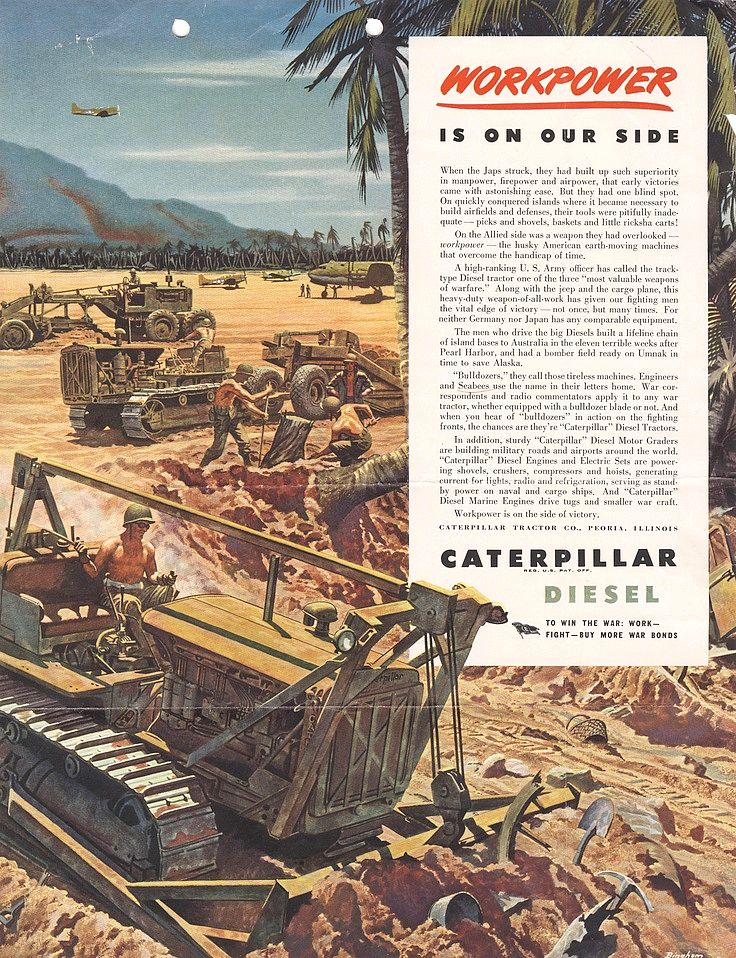 Company Poster on the M1 Tractor
Company Poster on the M1 Tractor
He acquired the licence in 1904 and produced his first tractor using differential braking tracks. He got rid of the forward tiller and steering wheel and these started operation in the Yukon, up to 1927. Given the limited market, the patent was sold to Holt. The future company name came from an anecdote by Company photographer Charles Clements which compared the track looking like a caterpillar but it could have been from British soldiers witnessing trials of the Hornsby tractor by July 1907. The first Holt Caterpillar had a track frame 30 inches (760 mm) high, 42 inches (1,100 mm) wide over 9 feet (2.7 m) long. These were costly but proved instrumental for muddy terrain and soon he patented a continuous track on December 1907 called the "Traction Engine".
Holt tractor of WWI
 Holt 75 Gun tractor towing a replica 8 inch gun at Great Dorset Steam Fair
Holt 75 Gun tractor towing a replica 8 inch gun at Great Dorset Steam Fair
On February 1910, a new plant was installed at East Peoria in Illinois and soon farm implement dealer Murray Baker became the company's executive vice president. This became the "Caterpillar Tractor Company". In 1910 the Holt was owned the trademark name Caterpillar. This proved so profitable through exports that the company acquired other sub-manufacturers. Soon, in 1914, the company demonstrated to the armies in Europe the way his tractors could tow any artillery piece on the worst terrain. It happened that the first tanks were manufactured by William Foster & Co. in Lincolnshire which collaborated with Hornsby on tractors for artillery already demonstrated by Holt to the British military in 1907 and using at the time paraffin (kerosene) engines.
Holt's tracked tractors soon became a staple of World War I prime movers. Holt shipped 1,200 tractors to the entente, France, Britain and Russia at the time for "agricultural purposes", but they were soon deployed to the frontline, hauling artillery and supplies in the worst conditions. Soon both in France and Britain, the Holt Tractor proved to be capable of receiving an armoured hull. This was the start of a long lineage:
Little Willie in Britain after trials at Aldershot in 1914, the
Schneider CA and
St Chamond tanks in France. Holt became the prime artillery tractor provider for the entente, between 6-in howitzer, 60-pdr, and up to 9.2-in howitzer. They were indispensible, and provided the basis for the first tank. In Short, Holt-Caterpillar greatly contributed to win the war. Since then many hiostorians had state the Holt Tractor had been "one of the most important military vehicles of all time", on par perhaps with the Jeep in WW2.
Caterpillar co. (1925)
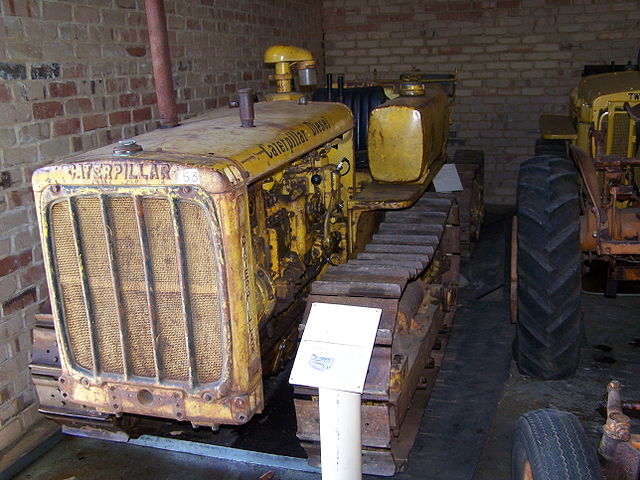 A Caterpillar D2, introduced in 1938, at the Serpentine Vintage Tractor Museum, Serpentine, Western Australia
A Caterpillar D2, introduced in 1938, at the Serpentine Vintage Tractor Museum, Serpentine, Western Australia
Bankers holding Holt's large debt contracted after WWI, forced the board to accept Thomas A. Baxter to succeed Benjamin Holt. Baxter eliminated large military or civilian tractors to focus on smaller, cheaper models targeted at the agricultural market. Thanks to the Federal Aid Highway Act of 1921 he provied also road-construction equipment, in competition to the Fordson company. Before that huge sums had been consumed in legal fees over contractual, trademark, and patent infringement lawsuits. So by April-May 1925, a merger saw the dominence of the market leader Holt Caterpillar as Caterpillar Tractor Co, headquartered in San Leandro until 1930, then Peoria. Clarence Leo Best became its CEO until October 1951.
Caterpillar had a short catalog limited to just five tracked tractors sharing a lot of elements: A 2 Ton, 5 Ton, 10 Ton range from Holt and the Caterpillar 30-60 from Best Tractor Co.'s. Two Holt models were eliminated in 1926 and the 2-ton by 1928 but saled went up by 1929, and then crashed in 1931-35. Diesel engines were adopted. In 1938 the company distributed it's "D" range.
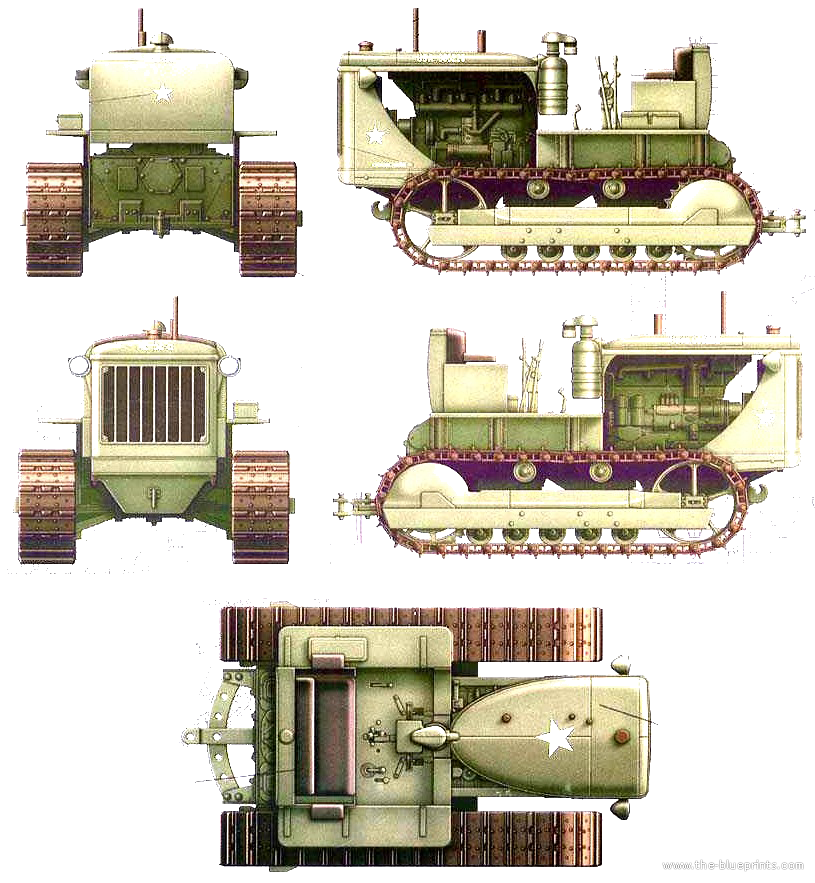
Fats forward and Caterpillar tractors were distributed to the US Army and produced by other countries under licence. They acquired famed in the Pacific, used by the Seabees, the construction battalions of the USN/USMC spamming airfields and facilities across islands, and sometimes fighting resident Japanese. Caterpillar eventually in 1945 ranked 44th among US corporations in wartime military production contracts. Postwar the company continued to grow and by 1950, became a multinational corporation now familiar as "Cat".
The D-7 lineage

The D7 manufactured in 1938 was the first after a long line of tractors following WWI. There was the D6 in 1935 (RD6) sporting a 3-cylinder 45 hp (34 kW) D6600 engine for example. The larger D8 was also presented the same year, in ww2 came its 2U Series rated for 148 hp (110 kW). There was the D5 (9M) originally built in 1939, but only 46 were built as a cross between the D4 chassis and 6-cyl. D6 45 horsepower (34 kW) D4600 engine. The D9 and D10 were introduced in the 1950-60s and the D11 in 1986. But the D7 was by far the most popular.
A series of improved models were produced postwar:
-D7C (1955)
-D7D (1959)
-D7E (1961) rated for 160 hp (120 kW)
-D7F (1969) rated for 180 hp (130 kW)
-D7G (1974) rated for 200 hp (150 kW)
-D7H (1986) rated for 215 hp (160 kW), first with elevated drive sprocket undercarriage.
-D7R (1996) and D7R Series 2 in the 2000s.
-D7E (2009) with Electric drive, 'flat-track' configuration.
-D7 (2020) with high drive, ongoing.
The Army M1 Heavy Tractor
The M1 Heavy Tractor was the United States Army generic term covering several civilian tracked tractors adopted for military use without change. The Ordnance Department wanted them as prime movers, ie for towing artillery and not as bulldozers. The Corps of Engineers tractors however had blades. But soon these unprotected, slow machines looked ill-suited for combat and gradually removed by several successive generations of armoured tractor, starting with existing turretless tanks. There were also dedicated models such as the Mack NO or "High Speed Tractors": M4, M5, or M6, all created and designed on purpose. Some tractors had crane attachments for payload handling as well. In all, over 1,000 M1 tractors were also leased to the Soviet Union (mostly of the Cat D7 type) for towing the 122, 152, 203 guns as an improvized prime mover. This was provisional as the Red Army already ramped up its tractor production with very competent models, albeit never in sufficient numbers.
Variants of the M1:
- Allis-Chalmers Model L
- G-022 Caterpillar Model 60
- G-89 Caterpillar RD7
- G-98, G-107 Allis-Chalmers HD-10DW
- G-101 International Harvester TD-18
- G-126 Caterpillar D7
- G-153 Caterpillar D8
Design
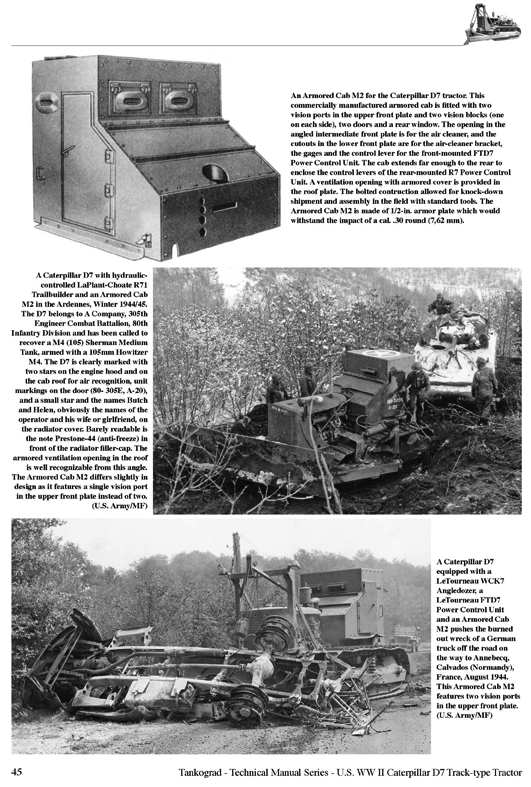

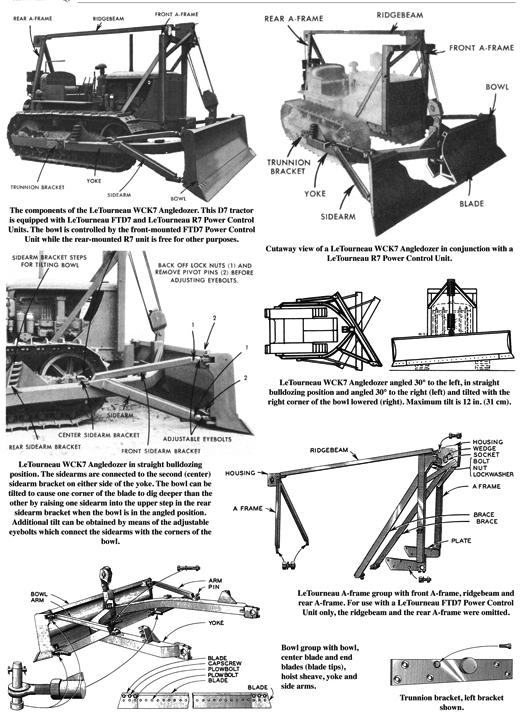
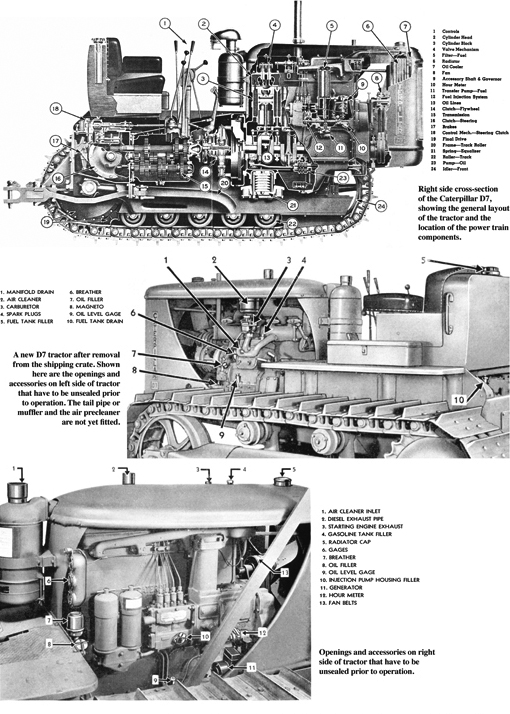
Dimensions and weight
By dimensions and classification, the M1 in military service was a heavy tractor, 160 in (4,114 mm) long for 97 in (2,539 mm) in width and 96 in (2,400 mm) in height and that was without any attachments, see options below, and it was phenomenally reliable. It weighted 31,870 lb (14,460 kg). It existed both as a prime mover (towing ordnance and equipment when nothing else was available) but mostly performed as earthmover and bulldozer. The D7 used several blades, like a straight ("S-Blade") short, without lateral curve, side wings for fine grading but also the more traditional Angle blade, 4' in height and attached on C-frame. It was later articulated by hydraulics on three angles. There was also the Universal and combined "S-U" blades developed postwar. There were many added options (see below).
Powerplant and performances
 D-8880 engine
D-8880 engine
The M1 was powered by a Caterpillar engine model D-8800, 4 cyl. 80 hp, 13.617 cc, liquid cooled diesel. Maximum drawbar pull was 11.500 kg and more. It was not known for blazing speeds: For a crawler, it barely registered beyond human pace, at 5-8 kph (3-5 mph). What power was not passed into speed was entirely delivered in torque. This vehicle was unstoppable. This powered could be passed onto a winch, a blade, or an hydraulic system to lift and tilt the blade.
Add-on Variants
LeTourneau Bulldozer (1940)
The XD7 Bulldozer was similar to the others above, but it's when Engaging the clutch of the power control unit that the blade was raised, and held when returning to neutral, or lowered again when releasing the brake. The XD7 Bulldozer could use front or rear rear-mounted PCUs and came at the front as knock-down kits with detachable blade and pushbeams. It surclassed the WEK7 Bulldozer thanks to its easy disassembly, compact stowage.
LeTourneau Angledozer (1942)
The LeTourneau WCK7 angledozer was a gear adapted to the D7 and composed of a steel blade across the front with supporting yokes and sidearms as well as trunnion brackets for pivoting the rear of the yoke. There front and rear A-frames as well as a ridgebeam supporting sheaves with a cable went through for raising the blade bowl, connected to the power control unit. As it went forward, this apparatus could elevate the dozer blade or adjust it into the best angled position or tilted position depending on the needs. This WCK7 angledozer could be installed in the field, with a simple cable drum, using the R7 PCU when available, and a spare drum. This was the standard angledozer type for the M1/D7 in ww2.
LeTourneau Tiltdozer (1943)
The A7 Tiltdozer also comprised a steel blade forward but with pushbeams to support the "bowl" and trunnion brackets, A-frames, ridgebeam for the cable and it can be operate either from the front or rear, where was located the Power unit. The blade was raised by engaging the clutch of the power control unit and lowered when releasing the brake, so to act both as bulldozer and angledozer. As the name suggest the blad was easy to tilt with precisions, using adjusting screws at the front of each tilting brace under a curved guard. Often these are recoinisable to their sharp pointed end blades. It likely arrived on the frontline from January 1944 onwards;
LaPlant-Choate R76F/R76R Trailbuilder:
The R76F is installed at the front and the R76R at the rear. These trailbuilders comprised the front steel blade, pushpoles, main support frame and tractor mountings for the main frame pivot. This combo trailbuilder was a essentially a cable-operated angledozer connected to a rear/front mounted PCU indifferently. Typically D7s came with a LaPlant-Choate R76F Trailbuilder and LeTourneau FTD7 front-mounted PCU, of the R76R Trailbuilder with LeTourneau R7 rear-mounted PCU. The blade had a 30° left-right adjustment to act as bulldozer. It could also be tilted up/down at either end. Introduction date unknown.
LaPlant-Choate R71 Trailbuilder (hydraulic)
The R71 trailbuilder was a hydraulic-operated angledozer like the one abobv, but it had a comprehensive hydraulic system (hydraulic pump, control valve, piping, oil reservoir, hydraulic jacks). The first is connected to the engine via a bracked mounting to the fan-belt pulley to raise and lower the blade. The trailbuilder outside track frames on pivot mountings are lifted/lowered by double-acting jacks, for down-pressure and lifting-power. The blade could also angle angled 30° either side and tilted as the previous model. Introduction date unknown.
Main WW2 Variants
- D7 7M series, manufactured 1940-1944, D8800 engine and 74 inch track gauge (1.880mm), c10,000 produced.
- D7A 1T1001 series, manufactured 1943, 138 made with Armor plating 7mm, twin hydraulic cylinders, rear mounted Hyster D7N winch
- D7 3T series, manufactured 1944-1955, c28,000 made
- D7 4T series, manufactured 1944-1945, no production figure
- D7 6T series, manufactured 1945, no production figure
The D7 in operations
The second world war was also a logistician war. As the dicton says "amateurs speaks tactics, professionnals speaks logistics". In WW2 in particular, the front was huge and fluid, with offensives and counter-offensives over long distances. This implied trains, trucks, staff cars, but also depots along the way. Engineers, especially in the Pacific, where infrastrycture was absent most of the time, were hard at work building bases, harbours, bases, depots, radio/radar stations, fortifications and airfields. For this, tracked tractor and bulldozers were heavily used for combat construction on all fronts, and in the US case, the mass-produced D7 came out as an absolute must.
It also often doubled as artillery prime mover when tractors were not available, as its ability for towing the heaviest field gun in the US arsenal, the 155 mm "long tom" on the worst terrain was invaluable. The tractor, unprotected and slow was sturdy as a rock and reliable even without maintenance, providing an answer to all tasks. Thanks to the numerous kits developed for it (see above), the D7 (most of the M1s were such vehicles) became the mule of construction teams anywhere. The D7 was at first a purely utilitarian vehicle, not supposed to see frontline action. It carried no armament nor armour, although some were improvized armour with scrap metal on the most debated campaign assignments, notably the seebees in the Pacific. Those that created Henderson Field at Guadalcanal in particular, were under constant fire from the Japanese. In fact the Seabees were its most praising crowd of all.
Its career did not stopped in WW2. Indeed, these were still used in Korea, and new variants saw action in Vietnam. Specially modified D7Es fitted with Rome plows cleared forests in the Vietnam war and some were up-armoured as they had to deal with Vietcong ambushes. Armored D7G clear minefields while unarmored D7G and D7H wree used for earthworks during the Gulf war. A full armor kit was developed for them by Israel Military Industries (IMI) and the US Army developed later a remote controlled version for mine-clearing. In 2009 the USMC replaced its D7Gs by Deere's 850J MCT but both the IDF and Egyptian Army today operates armored D7R II.
Read More/src
armyvehicles.dk
reviews.ipmsusa.org
en.wikipedia.org M1 Heavy Tractor
http://panzerserra.blogspot.com
list of US mil. vehicles by supply cat. designation
Caterpillar_Inc
Caterpillar_D7
usautoindustryworldwartwo.com
Video
Model Kits
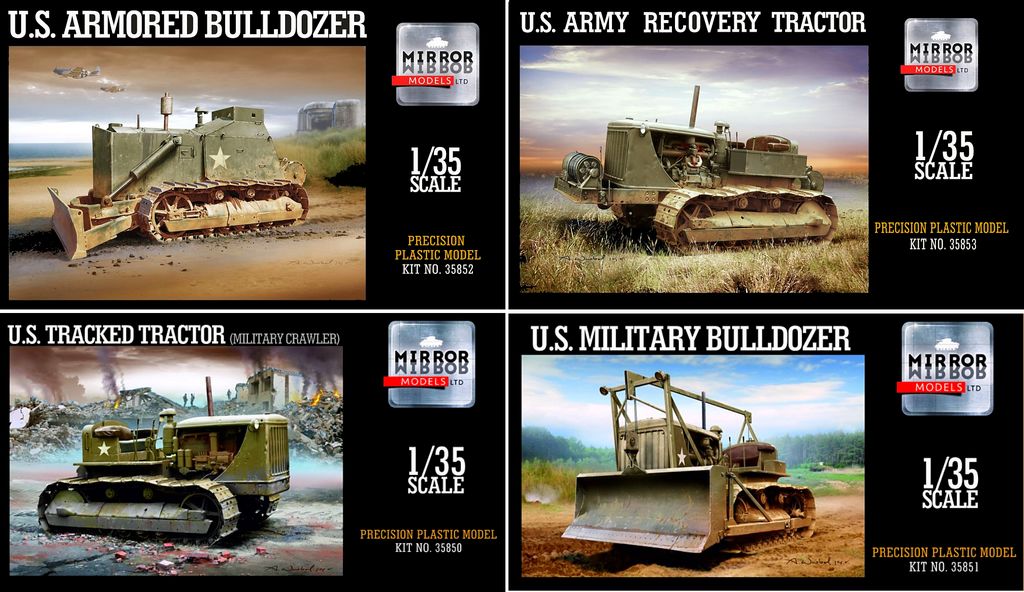 Several kits, often 1/35
Several kits, often 1/35